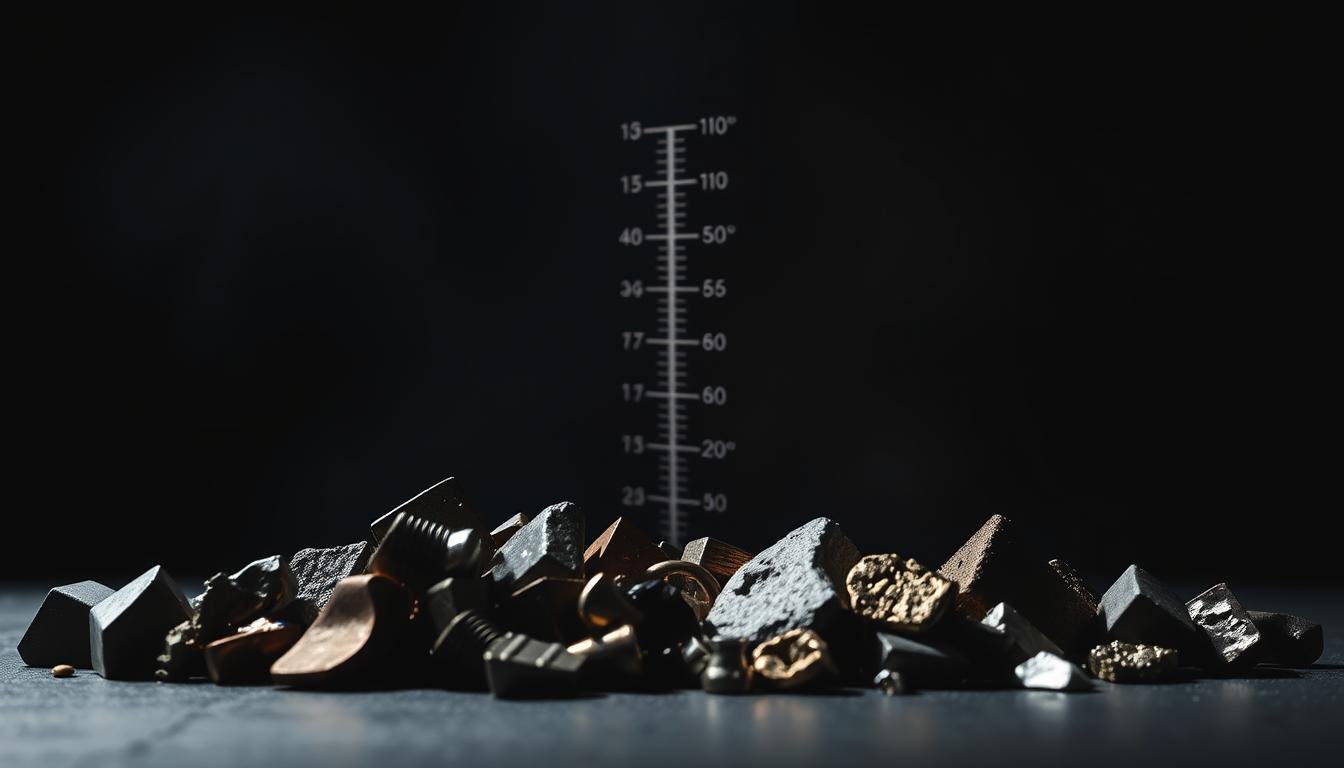Understanding how materials behave under heat is fundamental to modern manufacturing. When solid substances reach specific thermal thresholds, their atomic bonds begin to break down, creating a shift to liquid states. This transformative temperature varies significantly across different elements and alloys.
Engineers rely on precise thermal data to select materials for extreme environments. For example, jet engines require components that maintain structural integrity above 1,000°C, while plumbing systems need metals that flow easily during casting. These decisions directly impact product durability and safety protocols.
Atomic structure plays a decisive role in determining thermal stability. Stronger metallic bonds between particles demand higher energy inputs to initiate phase changes. This principle explains why tungsten withstands intense heat better than aluminum, making it ideal for aerospace applications.
Current industrial standards measure these critical temperatures using Celsius or Fahrenheit scales. At equilibrium states, materials exhibit both solid and liquid characteristics simultaneously – a phenomenon crucial for controlled casting processes. Advanced industries now use this knowledge to optimize 3D printing techniques and energy-efficient smelting operations.
This article explores how thermal properties influence material selection across sectors. We’ll analyze key factors affecting phase transitions and their practical implications for next-generation manufacturing.
Introduction to the World of Metal Melting
The transformation from solid to liquid states in materials is a cornerstone of industrial innovation. This shift occurs when thermal energy overcomes atomic bonds, a process governed by structural arrangements at microscopic levels. Understanding these principles helps engineers design safer jet engines, efficient casting systems, and advanced 3D-printed components.
The Science Behind Metal Melting
Metallurgists study how tightly packed atoms create robust metallic bonds. Closely arranged particles form stronger connections, demanding higher energy to separate. For example, tungsten’s dense lattice requires 3,422°C to liquefy, while aluminum’s looser structure melts at 660°C.
Electron behavior also influences thermal stability. Metals with mobile electrons distribute energy efficiently, strengthening bonds. This explains why copper maintains integrity in electrical wiring despite heat exposure.
Why Temperature Plays a Critical Role
Thermal thresholds determine material suitability for specific tasks. Aerospace alloys withstand extreme conditions because their atomic configurations resist bond-breaking energy. Conversely, low-temperature metals like tin flow easily during soldering.
Manufacturers rely on precise thermal data to select grades for casting molds or engine parts. Even minor impurities can alter these thresholds, affecting product reliability in critical applications.
What is Melting Point? Understanding the Phase Change
Material science relies on precise thermal thresholds to predict how substances behave during manufacturing. When a metal changes solid structures into flowing matter, this transition marks a critical physical property.
The Definition and Measurement of Melting Point
This critical thermal value represents the exact temperature where atomic bonds weaken enough to shift from a solid liquid state. Standard conditions typically yield consistent results, but extreme pressures or altered material forms can modify outcomes.
Engineers measure this property using calibrated instruments like thermocouples or spectroscopy. Industrial labs follow strict protocols to ensure accuracy, especially when testing alloys for aerospace or automotive use. Even 1% impurity can alter results by hundreds of degrees.
Manufacturers depend on reliable data to choose materials for casting molds or electronic components. For example, thin-film coatings melt at lower thresholds than bulk counterparts, impacting circuit board durability.
Advanced sectors now use nanoparticle analysis to predict phase shifts in experimental alloys. These innovations highlight why precise measurements remain vital for quality control and R&D breakthroughs.
Melting Point of Metals: Definition and Importance
Thermal thresholds determine how industries shape raw materials into functional products. Precise measurements guide decisions from aerospace engineering to electronics assembly, ensuring safety and efficiency across sectors.
Measurement Units: Celsius vs. Fahrenheit
Global industries use Celsius for its scientific precision, while Fahrenheit remains common in U.S. manufacturing. Conversion errors between scales can compromise material integrity. For example, titanium’s threshold is 1,668°C (3,034°F) – a critical detail for jet engine designers.
Impact on Manufacturing and Material Selection
Material choices directly affect production costs and product performance. Consider these factors:
- Energy efficiency: High-threshold metals require specialized furnaces, increasing operational expenses
- Workability: Low thermal stability metals like zinc simplify casting but limit high-heat applications
- Quality control: Automotive plants verify thresholds to prevent engine component failures
Electronics manufacturers prefer solders with precise phase-change temperatures to avoid circuit board damage. Meanwhile, construction firms select structural steels based on fire resistance ratings tied to thermal limits.
Factors That Affect Metal Melting Points
Industrial success often hinges on predicting how substances transform under thermal stress. Multiple variables determine when solid materials transition to liquid states, influencing manufacturing outcomes and product reliability.
Atomic Structure and Bonding
Stronger atomic bonds require more energy to break. Metals with tightly packed particles, like tungsten, resist liquefaction better than loosely structured elements. Electron mobility also matters—materials with free-flowing electrons distribute heat efficiently, maintaining stability.
Dense crystal lattices create robust networks that delay phase changes. This explains why nickel alloys outperform aluminum in high-temperature engines. Atomic size differences further affect thermal thresholds, with smaller atoms often forming tougher bonds.
Impurities, Alloying, and Particle Size
Foreign elements disrupt orderly atomic arrangements. Even 2% impurities can reduce thermal stability by 15%, compromising structural integrity. Alloying introduces complexity—adding chromium boosts steel’s resistance, while zinc lowers brass’s threshold.
Smaller particles melt faster due to increased surface exposure. Nanoparticles in 3D printing powders liquefy at 30% lower temperatures than bulk materials. Manufacturers leverage this in precision casting, using fine granules for detailed molds.
Quality control teams monitor these factors rigorously. Proper handling prevents contamination, ensuring consistent results across production batches. Advanced labs now use AI to predict how new alloys will behave under extreme heat.
Exploring Low Melting Point Metals and Their Applications
Specialized materials that transition from solid to liquid below 300°C enable unique manufacturing solutions. These substances reduce energy costs while allowing precision in delicate processes like electronics assembly and medical device production.
Notable Examples: Gallium, Tin, Bismuth, and More
Gallium becomes liquid at 29.8°C – slightly above room temperature. This property makes it perfect for thermal sensors and flexible electronics. Unlike mercury, it’s non-toxic and handles repeated phase changes without degradation.
Tin dominates soldering applications with its 232°C threshold. Its low thermal requirements prevent damage to circuit boards during component attachment. Modern alloys combine tin with silver for stronger joints in aerospace wiring systems.
| Material | Melting Temp (°C) | Key Uses |
|---|---|---|
| Bismuth | 271.3 | Dental alloys, fire sprinklers |
| Indium | 156.6 | Semiconductor seals, LCD screens |
| Lead | 327.5 | Historical radiation shielding |
| Mercury | -38.83 | Thermometers, switches |
Bismuth’s 271°C phase change supports safe casting of detailed dental impressions. Medical labs prefer it over traditional materials due to minimal shrinkage during cooling. Manufacturers also use bismuth-based alloys in fire safety systems.
Mercury remains liquid in standard conditions, enabling precise temperature measurement devices. Strict handling protocols now limit its use, but specialized laboratories still rely on its unique properties for sensitive experiments.
These materials demonstrate how low thermal thresholds drive innovation across industries. From energy-efficient foundries to miniature electronics, they provide solutions where high-heat metals would fail.
Discovering High Melting Point Metals for Extreme Conditions
Extreme environments demand materials that defy thermal limits. Industries like aerospace, energy, and advanced electronics rely on substances maintaining structural integrity under intense heat. These specialized materials enable technologies operating beyond conventional thresholds.

Key Metals: Tungsten, Molybdenum, and Titanium
Tungsten leads with a record 3,422°C threshold, surviving conditions that vaporize steel. Rocket nozzles and nuclear reactor shields leverage this stability. Its density and conductivity make it vital for electrical discharge machining tools.
Molybdenum withstands 2,623°C, ideal for furnace components and high-strength alloys. Modern nuclear plants use molybdenum-based materials in reactor cores due to minimal thermal expansion. This metal also enhances corrosion resistance in chemical processing equipment.
Titanium balances a 1,668°C phase-change temperature with exceptional strength-to-weight ratios. Jet engine compressors and spacecraft hulls utilize these properties. Advanced powder metallurgy techniques enable precise shaping for medical implants and military hardware.
Applications in Aerospace, Electrical, and Industrial Sectors
Critical systems depend on these materials:
- Hypersonic missile nose cones (tungsten)
- High-voltage circuit breakers (molybdenum-copper composites)
- Deep-sea drilling equipment (titanium alloys)
| Material | Thermal Threshold (°C) | Key Application |
|---|---|---|
| Tungsten | 3,422 | Plasma-facing components |
| Molybdenum | 2,623 | Glass manufacturing electrodes |
| Titanium | 1,668 | Satellite fuel tanks |
Emerging renewable energy systems now incorporate these metals in concentrated solar power receivers. Next-generation semiconductor production requires tungsten crucibles for silicon crystal growth. Economic factors drive research into cost-effective processing methods like electron beam refining.
Metals in Industrial Processes: Casting, Welding, and Fabrication
Thermal properties guide modern production techniques from start to finish. Foundries and factories rely on precise data to shape components through casting or welding. These methods demand materials that perform predictably under controlled heat.
Optimizing Manufacturing Processes
Casting efficiency improves when thermal thresholds match furnace capabilities. Aluminum’s lower liquefaction temperature reduces energy use compared to steel. Fabricators use this data to select alloys that balance durability with workability.
Advanced welding techniques require understanding how heat alters material structures. A detailed welding guide explains avoiding warping by managing thermal input. This prevents weak joints in pipelines or structural beams.
Energy Efficiency and Practical Challenges
High-temperature metals increase operational costs but offer long-term reliability. Manufacturers now use recycled materials in casting to cut energy use by 25%. Automated systems monitor heat zones during fabrication, reducing waste.
Balancing these factors ensures cost-effective production without compromising quality. From automotive parts to aerospace components, thermal knowledge drives smarter manufacturing processes worldwide.
